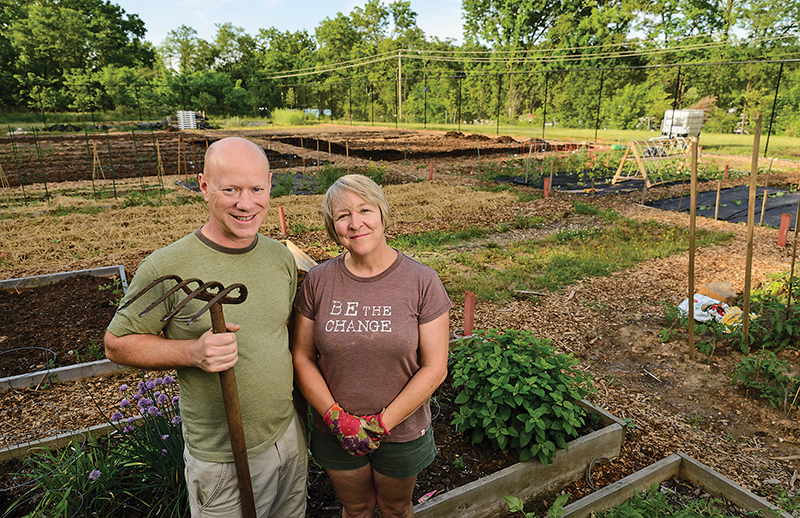Home & Living
Called to Cultivate
Baltimore’s master gardeners are no ordinary green thumbs.
If it’s a weekend in July, you can usually find Alice Moshenberg in her garden, scratching at the earth to harvest garlic or preparing seeds to plant in the fall. But by Moshenberg’s own diagnosis, she has something far more serious than the common gardening bug. “I’m a frustrated farmer, but I married a city guy,” says the 50-year-old operating-room nurse at Union Memorial Hospital. And since she can’t get enough of growing stuff, she’s now studying to become one of Baltimore City’s master gardeners, a diverse group of volunteer horticultural educators-to-be who train for 50-plus hours with agricultural experts from the University of Maryland.
Moshenberg sees the program as a way to extend her education and fulfill what she describes as an “urge” to work the land, be it a rooftop, container, or an abandoned city lot.
To these intrepid gardeners, even winter is no reason to rest. “It’s eye-opening to know you can grow something throughout the year,” says Moshenberg, who lives in Mt. Washington, a neighborhood teeming with deadly serious gardeners. “You can do root vegetables in the fall and greens like kale, celery, and tatsoi, a Japanese vegetable, that you can harvest in the snow,” she says. “In the fall, you put stuff to bed, like garlic, and sometime in July, you’ll get something.”
For Kenneth Montague, it was his postal carrier who inspired him to take the course. He was working on a shade garden in his yard when she came by with the mail and suggested he apply for the program. The next time he was at the farmers’ market, he did. This year, Montague, 73, a semi-retired lawyer, became the new president of the Baltimore City Master Gardener Association.
To accommodate people’s work schedules, the class is offered January through April in the evening. It costs $250. After completing classroom and hands-on training, master-gardener trainees must share their knowledge in the community to become certified.
“You don’t have to worry about me spending all my money on shoes or clothes, but you might have to worry about me blowing $300 in a seed catalogue.”
“You have from January to December to complete 40 hours of approved volunteer work,” says Montague, who lives in northeast Baltimore. “And that could be with anything from an environmental program to a school garden.” Once certified, master gardeners volunteer for at least 20 hours a year and continue to take classes.
Another person bitten by the bug is Woodberry resident Dave Nelson, 50, who you can usually find tending to his urban garden at the bottom of TV Hill. “We’re doing tomatoes, peppers, eggplants—four or five different varieties,” he says. “Squash is one of the easiest things to grow, as well as sweet potatoes.” Until four years ago, Nelson’s garden was an abandoned lot. And that spelled opportunity for him and his wife, Linda. The once vacant lot now yields about 1,200 pounds of organic produce a season, the majority of which is given away to local charities.
As in Moshenberg’s case, there are few parallels between Nelson’s gardening life and his work at a small tech company. “Gardening is so different from work, and one balances the other,” he says. And he and Linda took that rebalancing a step further when they enrolled in the master-gardener program together in 2013. As a result, their combined cultivating expertise is up several notches, plus they now have access to a network of other master gardeners, who can address any questions they might have.
Nelson is candid: For him and fellow experts, the gardening bug feels less like love and “more like obsession.”
“I was at a meeting with the master gardeners recently, and someone said, ‘You don’t have to worry about me spending all my money on shoes or clothes,’” recounts Nelson, “‘but you might have to worry about me blowing $300 in a seed catalogue.’”
One Baltimore City master gardener who, by day, is a couples and sex therapist, even sees a parallel between love of people and love of plants. Stephanie Chupein says she sees many similarities between her professional work and that of life in the garden. “Nurturing it until it blooms, it’s stress-relieving, your brain gets flooded with oxytocin, like when you’re falling in love,” says Chupein, who flower-gardens at her row house in Fells Point. “When I was going off to my first class, my sister said that when I get certified as a master gardener, I’ll be certified in all things birds and bees.”

Another master gardener, retired pediatrician Michael Andorsky, considers his plants “my new patients.” Although he has been gardening at his home near Park Heights Avenue for the past 30 years, he says most of his experience and information came through trial and error and the Internet. He says the master-gardener program has allowed him to continue with his love of learning. “The thing I enjoy best is when someone from the University of Maryland presents data. It’s a pleasure to see some scientific precision to demonstrate the point,” says Andorsky.
There are more than 150 master gardeners and trainees in Baltimore City, according to the master-gardener program coordinator, Naima Jenkins-El. But there is no such thing as a typical master gardener: “They are as different as our botanical friends,” she says.
On a recent Saturday morning at Lexington Market Jenkins-El—a classic example of a thoroughly urban gardener—dons a yellow master-gardener T-shirt and a smile that’s just as bright for a workshop she’s giving on growing vegetables in the city. The event is taking place in a surprisingly slick and large meeting room on the second floor of the market. Amidst the smell of fried food and the distant hum of conversation, participants ask the master gardeners lots of questions. When is the best time to water? (Answer: “In the morning.”) “How do you keep rats away from your compost?” (“Sanitation is the key to combating rats.”)
According to Jenkins-El, 43, gardening in the city’s empty lots is not as simple as claiming your land and digging. If you’re growing food, the first rule for gardening in the city is to have your soil tested. That’s especially true if there was once a house sitting on the tract, as is the case with most urban vacant lots, which may be contaminated with heavy metals like lead and arsenic.
To inner-city master gardeners like Jenkins-El, who does not have the luxury of large public, green spaces in which to work, it does not matter where you live—you can still grow something. “This year, I am growing potatoes in a bag,” she says. “I have seen things grow in milk crates. The coolest thing with urban growing is you’re only limited by your imagination.”
